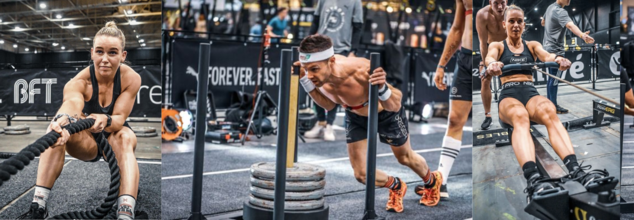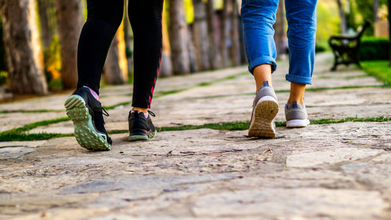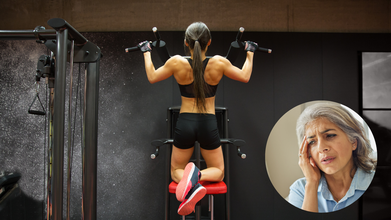- Health Conditions A-Z
- Health & Wellness
- Nutrition
- Fitness
- Health News
- Ayurveda
- Videos
- Medicine A-Z
- Parenting
- Web Stories
Is 'Hyrox' Challenge Worth The Hype Or Just Another Fitness Trend?

Image Credits: Hyrox
Fitness trends are like fashion these days—what’s in today might be out tomorrow. From everyone doing Pilates, to high-intensity circuits and suddenly to cold plunges. But what if we were to tell you that there's one challenge that combines endurance, power, and competition into one? That's what HYROX is all about, a global fitness race dominating both social media platforms and gym cultures alike.
Think of running, lifting, pushing, and jumping your way through a competition that caters to all fitness levels. That sounds intense and difficult, doesn't it? But is it another fitness fad? With Instagram accounts filled with fitness enthusiasts sweating out in big display halls, this endurance-based test has fascinated athletes and average fitness enthusiasts. But is HYROX really the next big functional fitness thing, or is it another fleeting hype?
What is HYROX?
HYROX is a competitive fitness competition that pairs endurance running with functional strength training. Even its name, a blend of "hybrid" and "rockstar," speaks to the blend of cardio and strength. It differs from marathons or obstacle course races in that it has a fixed format in all of its events globally. Contestants perform eight workout stations, each after a one-kilometer run, in an indoor venue intended to deliver uniform competition conditions.
HYROX Race Format
The competition is divided into eight rounds of a 1km run, with functional workout stations in between that challenge strength, endurance, and stamina. The workout stations are:
SkiErg – A cardiovascular exercise that mimics skiing.
Sled Push – The athletes push sleds with weights over a 50m course.
Sled Pull – A demanding full-body exercise that demands strength and technique.
Burpee Broad Jumps – A burpee and explosive jumping combination to travel distance.
Rowing – 1km row indoors on a rowing machine.
Farmers Carry – Kettlebells carried more than 200m.
Lunges with Sandbag – Sandbag lunges over 100m.
Wall Balls – Multiple weighted medicine ball throws into a wall.
Each one of these is to push endurance, mental fortitude, and physical ability, which is why it's a battle against the clock and oneself.
Since its inception in 2017, HYROX has been growing exponentially. The inaugural race in Hamburg, Germany, attracted 650 competitors, but in 2023, there were more than 40 worldwide races, and they had more than 90,000 athletes and 50,000 fans. The sport has especially caught up with individuals searching for an alternative to CrossFit and obstacle course racing.
Social media has been a major contributor to HYROX's popularity. The competitive aspect, coupled with the feeling of accomplishment upon the challenge's completion, has rendered it an inspirational event for global fitness enthusiasts.
How Does HYROX Compare to Other Fitness Trends?
HYROX differs from conventional endurance events and high-intensity training regimens such as CrossFit because of its formal, predictable design. In contrast to CrossFit, which mixes up workouts during each session, HYROX is the same everywhere in the world, with participants able to monitor progress and compare scores at competitions. The competition also favors endurance over brute strength, being more suitable for those who dominate long-duration workouts over heavy weights.
Furthermore, as opposed to obstacle course events like Tough Mudder or Spartan Race, HYROX is held indoors, which does away with natural conditions such as weather and uneven terrain. Such a controlled environment promotes fairness and consistency in competition.
Who Can Compete in HYROX?
One of the most attractive things about HYROX is that it is accessible. The competition is open to a wide range of people, from professional athletes to recreational fitness enthusiasts. With four divisions—Open, Pro, Doubles, and Relay—athletes can select the division that matches their fitness level. The relay format enables teams of four to divide the workout, which is a great option for those who wish to experience the challenge but do not have the endurance to go at full intensity.
Is It Worth the Hype?
For individuals looking for a competitive, endurance-based, and structured fitness challenge, HYROX provides a rewarding and distinctive experience. It encourages a well-rounded fitness experience through the intersection of running and strength training in a manner that is both engaging and motivating. Its growth in popularity and international spread indicate that HYROX is not merely a fleeting trend—it's a movement reshaping endurance sports.
HYROX has been lauded for its provision of a structured, goal-based fitness challenge. It facilitates overall fitness by including running, strength training, and endurance. Critics say it might not be for everyone. The high-intensity nature of the event is stressful on the joints, especially for those not used to hard physical work.
Most fitness enthusiasts identify HYROX as a valuable means of increasing overall physical fitness. The structure facilitates progression, with participants able to advance their times and proficiency over several events.
While some fitness trends fizzle out quickly, HYROX appears to have staying power. Its growing global presence, structured format, and competitive yet inclusive nature make it more than just a fleeting craze. Whether you’re a seasoned athlete or someone looking for a new challenge, HYROX provides an engaging and effective way to test your fitness limits. So, is HYROX worth the hype? For many, the answer is a resounding yes.
But Is HYROX Safe?
HYROX is accessible for all fitness levels, but it is physically challenging. Training, technique, and preparation are essential to prevent injury. Pre-existing health conditions require medical consultation prior to participation.
Long Walks Vs Several Short Walks? Study Reveals Which One Is Better For Your Health

(Credit-Canva)
Walking is said to be one of the best exercises. Not only is it an easy and accessible exercise, but it can be done anywhere and also does not need a lot of equipment. Many people aim for 10,000 steps a day as a sign of good health. But should you take one long walk, or multiple short ones? A new study has answered this question.
New research suggests that a single, longer walk each day is better for your heart than breaking up your steps into many short strolls, especially if you don't exercise regularly.
The study, published in Annals of Internal Medicine, found that walking for at least 15 minutes without stopping is ideal. This longer, steady pace, which is about 1,500 continuous steps gives your heart a much better workout.
Longer Vs Shorter Walks: Which is Better?
Researchers tracked the walking habits of over 33,500 adults in the UK who walked less than 8,000 steps a day. After tracking their health for eight years, the findings were clear:
Lower Heart Risk
People who consistently walked in longer, uninterrupted stretches had a lower risk of heart problems compared to those who only took short, quick bursts of steps.
Why Are Longer Walks Better For Health?
Even among the least active group (those walking under 5,000 steps daily), taking longer walks made a major difference. Their risk of heart disease and early death dropped significantly.
The researchers explain that most people focus only on the number of steps they take, but not the patterns. They suggests that even inactive people can boost heart health by changing their habits to walk for at least 10–15 minutes at a time.
Should People Focus More On How They Walk Or How Much?
Many people aim for 10,000 steps a day, but that number actually came from an old pedometer advertisement, not science. While experts agree more steps are generally good, this study emphasizes that how you walk matters more than just the total step count.
The researchers suggest that simple changes, like setting aside time specifically for a long walk, could make a big impact on heart health.
The NHS still recommends getting 150 minutes of moderate activity like brisk walking, each week, and ideally it should be spread out. For older adults, moving every day, even with light activity around the house, is key.
It's important to know that while the study shows a strong link between longer walks and better health, it doesn't definitively prove that walking directly causes the improvement.
However, health experts agree exercise is vital. They explain that you might find it hard at first, but it will get easier as your body adjusts. Even small improvements contribute to a healthy heart.
What Are Some Safety Tips for Walkers?
While walking is generally a safe activity, accidents can happen, especially if you like to walk alone. To stay safe while walking,
Be Visible
Wear bright, reflective clothing or carry a flashlight after dark or in dim light so drivers and others can easily spot you.
Stay Alert
Focus on your immediate surroundings; avoid distractions like your phone or headphones to always know what's happening around you, especially traffic.
Use Paths
Walk or bike only on marked paths, lanes, or sidewalks, and cross streets at designated crosswalks where vehicles are expecting pedestrians.
Donald Trump Health Update: First Hand Bruise, Now Swollen Ankle, Is The President Hiding A Health Crisis?

Credits: AFP/X
Donald Trump health has become a heated topic of debate and the concerns around his health has resurfaced after a photo from his Kuala Lumpur visit on Sunday, October 26, went viral. He was spotted with swollen ankles. The photo that went viral is from a meting of the Association of Southeast Asian Nations (ASEAN), which kicked off his six-day trip.
The pictures of his swollen ankle have flooded on social media and people are saying that his ankle is seen to be extremely swollen. As per experts, this happens due to chronic venous insufficiency, which is a condition Trump had earlier announced to be suffering from.

Chronic venous insufficiency occurs when the veins in the legs have trouble sending back to the heart. This causes blood to pool and creating high pressure. This is usually caused by damaged or weakened valves in the veins and is characterized by symptoms like leg swelling, aching, and heaviness, which improves with elevation. Risk factors include age, a history of deep vein thrombosis, and prolonged periods of sitting or standing.
However, Trump's latest physical test says something else. The White House physician Sean P Barbabella declared that the president "remains in exceptional health, exhibiting strong cardiovascular, pulmonary, neurological, and physical performance". Barbabella also stated that his "cardiac age was found to be approximately 14 years younger than his chronological age".
Trump's Legs Could Also Reveal That He Had A Stroke
As per a "Physical Therapist", who posts videos on Instagram by the username @epistemiccrisis with 74.2k followers, Trump also had his peroneal nerve paralyzed. He explains, "The deep branch of common peroneal nerve, which supplies a muscle known as the tibialis anterior, which blends your foot up toward your head when you walk. This is known as dorsiflexion. If this nerve is paralyzed, you would get a foot drop."
However, he notes that this can be easily remedied with a brace, called ankle foot orthosis or AFO. He said that the president was most likely wearing it as the outline of the posterior portion of "what looks like an AFO" could be seen through his pants.
Concerns On Trump's Health
Previously, the same "Physical Therapist" claimed that President Trump had a stroke. This is because he had difficulty walking in a straight line. In fact, a 2021 study published in journal Healthcare notes that stroke is a major cause of disability worldwide and balance impairments are common disabling factors in patients with stroke, which could lead to falls.
However, as per the official medical records of the president, no such strokes were mentioned. His medical report pronounced him in "excellent health". The examination was done at Walter Reed National Military Medical Center. The report also emphasized that Trump maintains a "demanding daily schedule without restriction". Not only that, the report has gone so far to declare Trump's cardiac age as 14 years younger than his actual age after an electrocardiogram.
This Simple Grip Test Could Predict Your Dementia Risk

Credits: Canva
Dr Peter Attia, physician, and researcher known for his work in longevity medicine believes that there is a correlation between your grip strength and dementia onset risk and dementia mortality.
Dr Attia says, "My best explanation for this is that grip strength is itself a proxy for overall strength. The type of strength we are talking about here is acquired, not inherited. You had to do a bunch of work to get it, and it is the work you did that is actually what's protect your brain."
He says that women who are over 40, must be able to hand on a bar for a minute and a half, and for men, it is two minutes. The key is that you are supposed to be able to carry 75% of your weight, he says, in an interview with CBS News' 60 minutes.
Is There Any Truth In The Claim That Grip Strength Has A Correlation With Dementia?
As per a 2021 study published in journal Frontiers in Aging Neuroscience, titled Grip Strength and the Risk of Cognitive Decline and Dementia: A Systematic Review and Meta-Analysis of Longitudinal Cohort Studies, loss of grip strength and cognitive impairment are prevalent in the elderly, and they may share the pathogenesis in common.
The study found that poorer grip strength was in fact associated with more risk of cognitive decline and dementia. The subgroup analysis within the study also indicated that people with poorer strength had more risk of Alzheimer's disease and non-AD dementia.
But why does this happen? Lower grip strength is a marker for overall muscle mass, general health, and is linked to the health of the brain and its blood vessels. This link is also connected to other factors like vascular health, cognitive decline, and physical activity, as low grip strength can be a symptom of poor overall physical and metabolic health.
How Is Lower Grip Strength Is Linked To Dementia?
Indicator Of Overall Health: Grip strength reflects the health of entire body, this is why a lower grip strength is an indicate of lower muscle mass, and general poor health.
Vascular and brain health: Since there is a connection between muscle strength, blood flow, and brain health, thus lower grip strength is associated with a higher risk of vascular dementia and a greater volume of white matter hyperintensities in the brain.
Also Read: What Home Gym Tools Can Help You Stay Fit Without Hitting The Gym?
Poorer grip strength is associated with lower cognitive function, such as fluid intelligence and prospective memory. This suggest a link between the body's physical capabilities and the brain's cognitive abilities.
A different study published in 2022, where 40,000 participants from the UK Biobank were studied found that greater grip strength was associated with better cognitive functioning, higher life satisfaction, greater subjective well-being, and reduced depression and anxiety symptoms while controlling for numerous demographic, anthropometric, and socioeconomic cofounders.
The study also found that grey matter volume of subcortical region also correlated with better mental health and considerably mediated their relationship with grip strength.
© 2024 Bennett, Coleman & Company Limited

